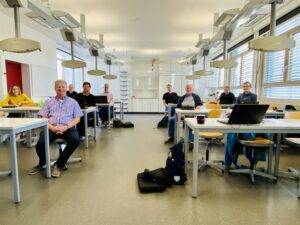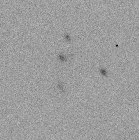-
Faulkes Telescope Project Privacy Policy
Teachers involved in the discovery of a comet
by Paul Breitenstein and Paul Roche
C/2020 S4 (PANSTARRS) is the scientific name of a newly discovered comet, which teachers were able to confirm during their teacher training workshop at the Pascal Gymnasium Münster, Germany.
C/2020 S4 (PANSTARRS) is classified as a Jupiter family comet, and was discovered by the Pan-STARRS 1 telescope (located near FT North on Maui) on September 16th 2020. This completely robotic telescope scans the sky for moving objects every clear night. Of particular interest are near-earth objects and comets that are collected and published by the Minor Plant Center (MPC) at Harvard-Smithsonian Center for Astrophysics.
“But a discovery without independent confirmation has no scientific value!” explains Paul Breitenstein (Astronomy and internet in Münster, AiM), who organised a teacher training workshop at the Pascal-Gymnasium, Münster, Germany on 25th September 2020. The workshop introduced teachers to the robotic telescope facilities available to them, with a particular focus on the Faulkes Telescope Project, which Paul has been working with for many years.

The Münster teachers who attended the AiM workshop in September 2020 and helped to confirm the existence of C/2020 S4 (PANSTARRS).
To help with the search for independent confirmation, the nine teachers at this workshop looked at images made the day before following requests from AiM for observations with the 2m Faulkes Telescope South in Siding Spring, Australia – and they found what they were looking for!
A small point of light was seen moving through the eight images taken near the predicted position of the comet, in the constellation of Eridanus. The measured values were immediately reported to the Minor Planet Center by email, and just minutes later were used by the Harvard scientists to improve the predicted position and orbit of the comet.

Animation showing the motion of comet C/2020 S4 (PANSTARRS) between the 8 FTS images obtained by AiM for the teacher training workshop.
The object was recognized by the MPC as a new comet only after nine other international teams had confirmed its existence, and on September 28th, 2020 it was named as comet C / 2020 S4 (PANSTARRS) with a Minor Planet Electronic Circular MPEC 2020-S239, and assigned to the Jupiter family.
“Astronomy in school needs an upgrade” Paul Breitenstein is certain. In the new Physics curriculum of the German state of North Rhine-Westphalia, astronomy is given a new status, but knowledge of new digital possibilities for schools has generally remained in the 20th century.
This is where the AiM teacher training workshop “Astronomy 2.0” comes in. With the help of AiM, teachers in Münster and nearby have learned how to access large research telescopes with their students. These 21st century digital opportunities open the possibility for school students to participate in current scientific work and make small contributions, e.g. in the discovery of asteroids or comets.
